
22 Nov EXCURSION: BACKCOUNTRY SKI LODGES
My first backcountry ski lodge experience was back in the late 1990s when some friends and I rented an old yurt two blocks off Main Street in Cooke City, Montana. We paid $5 for a snowmobile ride from town up to Daisy Pass in the Beartooth Mountains, ripped powder all day, and then finished with one of my most memorable snowboard runs ever: an untracked 3,000-foot descent right back into town. Exhausted, we settled into our rustic accommodations and fell asleep with the cheek-to-cheek grins that only a day in the mountains could provide. I was hooked.
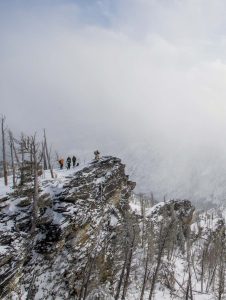
Skiers examine the backcountry terrain in the rugged Bitterroot Range near the Downing Mountain Lodge. | COURTESY OF DOWNING MOUNTAIN LODGE
Backcountry skiing and snowboarding have come a long way since then. Cabins, yurts, and lodges have sprung up throughout the region, allowing easier access to the surrounding mountains and providing more comfortable accommodations. Certified guides are available to snowmobile your gear in and show you the best powder stashes. Often, a home-cooked meal awaits after a leg-burning day of climbing and skiing. Rest and repeat.
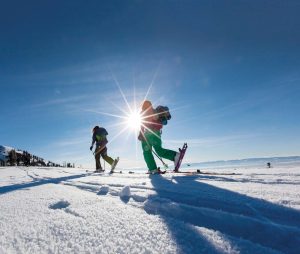
Snowshoers take advantage of sparkling Teton-shadowed expanses at one of the yurts offered by Teton Backcountry Guides. | COURTESY OF TETON BACKCOUNTRY GUIDES
Make no mistake, these aren’t five-star resorts. There are no helicopters or snowcats that take you to the top. You have to earn your turns; you need to be in good physical condition. This is the appeal though, to a growing number of skiers and snowboarders who want the rewards of the backcountry with a certain level of coziness. According to SnowSports Industries America, the number of skiers in the country who consider themselves alpine touring participants has shot up from 700,000 just a few years ago to more than 2 million today. This growth is happening across all demographics, including age, gender, ethnicity, income, and education.
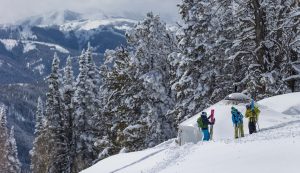
Yurts like the Baldy Knoll offered by Teton Backcountry Guides make a great base camp to explore the surrounding terrain. | COURTESY OF TETON BACKCOUNTRY GUIDES
“Our client base ranges from people who are new to the backcountry all the way up to experts and professionals,” says Reed Youngbar, owner of Beartooth Powder Guides in Cooke City. “We love introducing people to the backcountry just as much as we like getting out with seasoned backcountry skiers.”
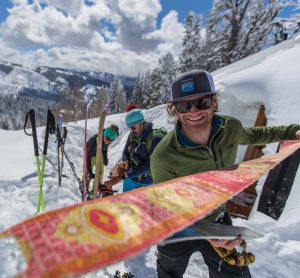
A skier removes his climbing skins an readies for the descent. | COURTESY OF TETON BACKCOUNTRY GUIDES
Equipment is also getting better and more accessible, from snowboards that split in half for touring to backcountry skis, boots, and bindings that are getting lighter every year. Following this growth, the Winter Olympics will feature the sport of ski mountaineering for the first time in 2026.
If you’re a decent resort skier and want to get into the backcountry, you can ease into it and see what works for you. These days, you can even rent touring gear before you decide to plunge into the expense of added equipment.
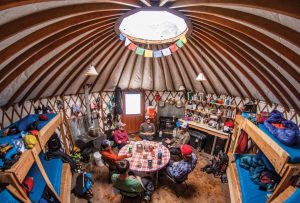
The cozy confines of Bell Lake Yurt are perfect for small groups to enjoy the Montana backcountry. | COURTESY OF BIG SKY BACKCOUNTRY GUIDES
“It can be a bit daunting to get into backcountry skiing; the gear alone is a solid investment,” says Youngbar. “A great place to start is a guided day with a professional on rental gear. Guides have a wealth of knowledge about gear and backcountry travel, and you can learn a ton by spending just one day with a guide.”
Those with the knowledge and proper equipment can also rent a backcountry yurt or cabin for more of a self-guided experience. Either way, you’ll have a memorable time in the mountains, and you’ll most likely be ready to book another trip the minute it’s over.
Baldy Knoll, Commissary, Plummer Canyon, and Teton Canyon Yurts
Located on the west side of Wyoming’s Teton Mountains, Teton Backcountry Guides offers four mountain yurts that access various terrain options in one of the country’s most iconic landscapes just outside Grand Teton National Park. Three of them — Baldy Knoll, Commissary, and Plummer Canyon — sit at more than 8,000 feet and are near beginner, intermediate, and expert terrain. The fourth, Teton Canyon Yurt, is at a lower elevation and can be reached by a 4-mile groomed Nordic track perfect for backcountry beginners. While visitors can take snowmobiles to two of the yurts, human power is the way to go to take full advantage of the jaw-dropping mountain views on the way in.
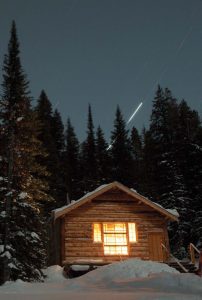
The Woody Creek Cabin is a spectacular and comfortable base camp for backcountry adventures. | COURTESY OF BEARTOOTH POWDER GUIDES
“I’ve lived here for more than 30 years, and they still take my breath away,” says owner Diane Verna. “Being able to skin up into the mountains and admire these jagged peaks and then ski down through over 3,000 feet of blower powder in such a beautiful place is just beyond anything you can experience at a ski resort.”
Each yurt measures 20 feet in diameter, has a private, sheltered latrine, and is accessed via an approximately 4-mile approach into the mountains. They sleep six to eight people and feature a wood stove and propane cook stove while offering lanterns, pots, pans, and utensils. For self-guided trips, you just need to bring your own food, drinks, and personal items — though a guided first day is required for groups that have not previously rented one of the yurts. Fully catered trips are a great option for up to six people; they include all meals and offer two guides per group so that your party can simply arrive with personal gear, and the guides take care of the rest.
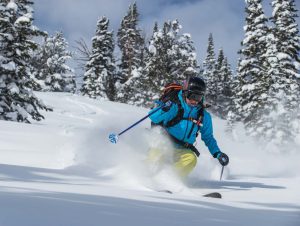
Terrain accessible from the Bell Lake Yurt includes gladed powder stashes. | COURTESY OF TETON BACKCOUNTRY GUIDES
“Our yurts are visited by folks of all ages who enjoy a unique winter getaway,” says Verna, who, along with her partner, Jeff Jung, is celebrating 25 years of owning the business this winter. “You can spend the night in the high country at the edge of the wilderness, ski untracked powder all day, and return to a warm, cozy yurt.”
Bell Lake Yurt
When I moved to Bozeman, Montana in the 1990s, I avoided the crowds in the Bridgers and honed my backcountry snowboarding skills in the more isolated Tobacco Root Mountains west of town. These days, guests can enjoy the Bell Lake Yurt, located at 8,500 feet in the shadow of the range’s impressive Branham Peak. It’s a cozy winter retreat with exceptional access to thousands of acres of backcountry ski terrain suitable for every ability level.
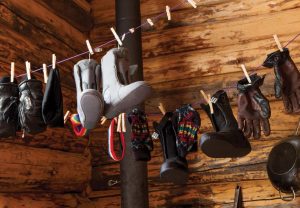
Boots hang to dry in the Woody Creek Cabin after a day of backcountry touring. | COURTESY OF BEARTOOTH POWDER GUIDES
“The Tobacco Roots are high, wild, and tough to access — perfect for backcountry skiing and the very reason we have a yurt located in the middle of the range,” says owner Drew Pogge, who also operates Big Sky Backcountry Guides. “There’s terrain for almost anyone, and our mission is simply to meet folks where they are in regard to experience and preferences and have an awesome time skiing.”
Pogge and his crew run everything from guided and catered multi-day trips to day tours, and experienced groups can rent the yurt to explore the backcountry on their own. Specialized trips, like the Montana Haute Route, give a small group of skiers the unique opportunity to traverse the entire length of the rugged range, and Pogge teaches a robust avalanche education program — a must for anyone who decides to spend time in the backcountry.
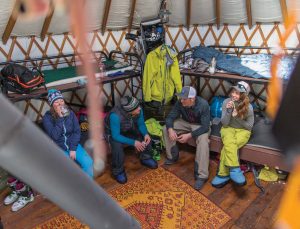
Skiers relax in Baldy Knoll Yurt after a day skiing in the Tetons. | COURTESY OF TETON BACKCOUNTRY GUIDES
“We educate all levels of backcountry skiers and riders and help tons of people begin or continue their backcountry experience safely,” says Pogge. “It’s such a blast to be able to introduce them to the best skiing and riding in Montana.”
Like most backcountry yurts, the one at Bell Lake can accommodate up to eight guests and features a fully contained kitchen, wood stove, solar-powered light system, and a separate outhouse. The yurt offers views of multiple granite-walled couloirs descending from Branham Peak but also serves excellent gladed terrain and wide-open bowls — a true playground for all abilities.
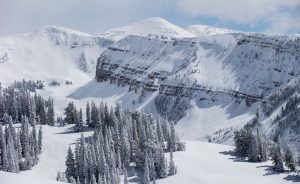
Mountain scenery is always stunning in the Teton backcountry. | COURTESY OF TETON BACKCOUNTRY GUIDES
“We love all aspects of living and playing in the backcountry, and Bell Lake Yurt is an incredible spot,” says Pogge. “It’s an honor to share it with people.”
Downing Mountain Lodge
The Bitterroot Mountains southwest of Missoula, Montana hold a special place in my backcountry heart — it’s the first spot I ever went as a young graduate school student, hauling an old pair of skis up above the Bass Creek drainage in the spring. The Bitterroots aren’t the first to come to mind when people think of backcountry skiing in Montana but the massive range opens up endless opportunities, and the Downing Mountain Lodge is the perfect base camp from which to explore the surrounding terrain.
The lodge sits at 5,500 feet and is downright luxurious for a backcountry ski destination. Featuring three bedrooms and an open loft, it boasts a maximum capacity of 15. It has electricity, two bathrooms, a commercial kitchen, a fireplace, a six-person hot tub, and even a foosball table. When taking into account the thousands of skiable acres directly behind the lodge, it’s a hard place to leave. And getting there is relatively easy: just a 1.5-mile and 700-foot vertical ski on a U.S. Forest Service road.
“Downing Mountain Lodge is unique as the access is from a privately built and maintained summer road,” says owner John Lehrman, who has been hosting guests at the lodge since 2008. “There is no competition with day skiers or snowmobiles.”
Lehrman also operates Bitterroot Backcountry Ski Guides, the only authorized and permitted backcountry ski guide service in the Bitterroot National Forest. He and his crew tour guests from the lodge and other locations throughout the range, including numerous options with 3,500-foot descents. One of the more unique things about the terrain around the lodge is the burnt gladed skiing; that is, skiing through a treed area that was burned by a forest fire in 2012. It’s a magical, almost spiritual feeling — simply put, it’s one of the coolest things to experience.
From the lodge, ski runs range from short, intermediate shots to 2,800-foot fall-line runs off the summit ridge. Advanced skiers and riders can access steep alpine bowls and faces, cliff lines, and rocky chutes, while there are plenty of moderate, north-facing glades for those high-avalanche-danger days. It’s a spectacular setting where anybody can enjoy the mountains.
“In the end, it’s really all about gathering your best friends and sharing an experience deep in the mountains,” says Lehrman.
Mount Zimmer Yurt and Woody Creek Cabin
The scene around Cooke City has come a long way since my experience many years ago. While still revered as a snowmobile mecca drawing people from all over, it has also become one of the country’s premier backcountry skiing destinations. Situated just outside the northeast entrance to Yellowstone National Park, it’s an end-of-the-road place between the Beartooth and Absaroka mountains.
“Typically, Cooke City has one of the deepest snowpacks in Montana,” says Youngbar of Beartooth Powder Guides. “It’s a bucket-list destination for many backcountry skiers from around the world.”
Youngbar operates out of two lodging locations — Mount Zimmer Yurt and Woody Creek Cabin. The yurt sits at 9,500 feet — just north of town at the edge of the wilderness boundary — and offers easy access to powder-filled bowls, chutes, and glades probably best suited for advanced skiers who want to test their skills. At 8,700 feet in elevation, the 20- by 24-foot log cabin is nestled in the forest near the confluence of Woody and Hayden creeks and just a 2.5-mile ski from downtown Cooke City on the south side of the highway. It sleeps 10 and includes everything you need for your stay, making it a great base camp from which to explore the surrounding backcountry.
Youngbar and his team also teach a variety of avalanche education programs, including women’s-specific avalanche and ski-mountaineering courses, which can serve as a great way to get into the backcountry.
“If you are going to make a long-term commitment to backcountry skiing or splitboarding, it is imperative that you become educated about the risks of avalanches,” Youngbar says. “This is a great place to start if you have the gear and are comfortable skiing powder at the resort.”
However you take advantage of the backcountry lodging options around the region, you’re bound to have a memorable experience. Just being away from civilization and enjoying the scenery makes it all worth it. The powder turns are a bonus.
“If you love it after a day, congratulations — you have a lifetime of amazing backcountry adventures ahead,” says Pogge. “And if you don’t love it, that’s OK, too — you’ll still have spent a great day in the mountains.”
Brian Hurlbut is the author of Insiders’ Guide to Yellowstone and Grand Teton (Globe Pequot) and Montana: Skiing the Last Best Place (Great Wide Open) and his writing appears regularly in regional publications. He lives in Big Sky, Montana where he enjoys the trails, mountains, rivers, and roads.




No Comments